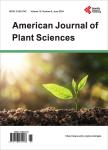Ultrastructural and Physiological Characterization of YELP, a Novel, Yellow, Chlorophyll-Deficient Cell Mutant Line That Develops Etioplast-Like Plastids in the Light
Ultrastructural and Physiological Characterization of YELP, a Novel, Yellow, Chlorophyll-Deficient Cell Mutant Line That Develops Etioplast-Like Plastids in the Light作者机构:Potgrado en Botánica Colegio de Postgraduados Texcoco México Campo Experimental Bajío Instituto Nacional de Investigaciones Forestales y Agropecuarias Celaya México Programa de Posgrado Instituto Tecnológico de Roque Celaya México
出 版 物:《American Journal of Plant Sciences》 (美国植物学期刊(英文))
年 卷 期:2016年第7卷第3期
页 面:510-524页
学科分类:0710[理学-生物学] 071001[理学-植物学] 07[理学]
主 题:Cell Suspension Chloroplast Biogenesis Prolamellar Body Ultrastructure
摘 要:In this work, we present an ultrastructural and physiological description of a novel chlorophyll-deficient, yellow cell line of the grass Bouteloua gracilis that develops etioplast-like plastids in presence of light (YELP). These mutant cells were compared to the parental, wild-type, highly chlorophyllous cells from which they were isolated. Growth analysis, based on fresh and dry weights, indicated that YELP accumulates biomass at a slower rate than the parental, green cells. Besides, YELP developed very low levels of photosynthetic pigments, reaching only 9.3% and 38.4% of chlorophyll a and chlorophyll b, respectively, developed by the wild-type cells. Likewise, the accessory pigments, carotenes and xanthophylls, were only synthesized at 8.0% and 5.4%, respectively, of the levels reached by the green cells. Electron microscopy revealed remarkable differences in plastid ultrastructure between the wild-type and mutant cells. Plastids of YELP were heterogeneous and smaller than those found in wild-type cells. YELP plastids were abnormal with poorly developed membrane systems that prevented the accumulation of chlorophyll and accessory pigments in the mutant cell line. We expect this novel, mutant cell line will provide new tools for studying plastid development and differentiation.



